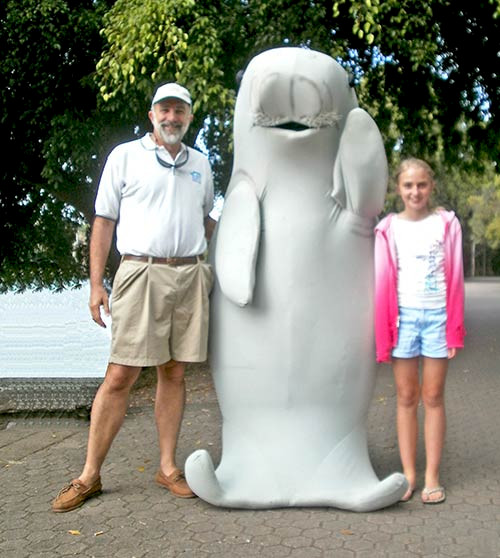Dugong Rock; Using iconic creatures in conservation
Bill Dennison ·The appeal of iconic creatures has long been used to generate support in the conservation movement. Whales and dolphins in the sea and pandas, gorillas and other apes on land have been and still are conservation icons. WWF still uses the panda in their logo, for example. Icons like birds, particularly raptors, are fairly global. Other icons are rather regional, like Komodo dragons in Indonesia or lemurs in Madagascar. Icons like penguins and polar bears in antarctic and arctic regions, respectively, may not be viewed in situ by many people, yet they remain globally significant. A conservation icon in northern Australia is the dugong, a marine mammal that feeds on seagrass.
Several years ago, Dr. Peter Oliver wrote a song called "Dugong Rock". One of the reasons that Peter chose a dugong for his song as a conservation icon is that dugong feed almost exclusively on seagrasses. Seagrasses are the 'coastal canaries', in that they are particularly susceptible to light reductions due to turbidity. In Queensland, the recent flooding has led to light reductions and subsequent seagrass loss. Since human activities on the watershed influence the amount of sediments and nutrients that are in flood waters, the message is that to properly look after dugongs, we need good watershed management. We will be anxiously watching over the coming months for dugong migration as they search for food and potential mortality, as they succumb to starvation.
Recently, some conservation groups have asked for help in publicizing the water quality issues they are facing and Peter's response was to launch a video competition for groups to produce and post 3 minute videos using his song "Dugong Rock". Peter even initiated a mini-flash mob with his own organization, the International WaterCentre. On a sunny lunch break in downtown Brisbane, the IWC staff, joined by the International RiverFoundation staff, went out onto Cathedral Square and danced to "Dugong Rock". They entrained a random street person, startled the business crowd on their way to lunch and clearly had a good time.
International WaterCentre and International RiverFoundation staff performing in Cathedral Square.
Several other groups responded to the "Dugong Rock" challenge and have posted their version of "Dugong Rock" on YouTube. The Healthy Waterways group performed with "Hugo the Turtle" and "Doug the Dugong" on the Kirpala Bridge. A school group of fifth grade students performed on stage of their school. I joined the IWC students enrolled in the Masters in Integrated Water Management course in their rendition of "Dugong Rock", performed along the Brisbane River in the Botanic Gardens. They took turns playing the part of "Doug the Dugong", inside a large, heavy foam dugong costume. The funniest thing was when a small Chinese student tripped over her dugong flippers and softly fell to the ground but was laughing too hard to escape from the costume.

While having dancing dugongs in downtown Brisbane may not do much to change the world, it sends the right message about conservation of these iconic creatures and the habitats they depend on (seagrasses). It is also good fun, and it is hard to take yourself too seriously when cavorting in public with "Doug the Dugong". My hope is that the fifth grade school children will remember their wonderful performance and sometime later in life will make the right decisions that insure that the dugongs will have a place in the world. When I reflect on all of the things I will have done during my sabbatical in Australia, dancing to "Dugong Rock" will be high on my list of favorite things.

About the author
Bill Dennison

Dr. Bill Dennison is a Professor of Marine Science and Vice President for Science Application at the University of Maryland Center for Environmental Science.

